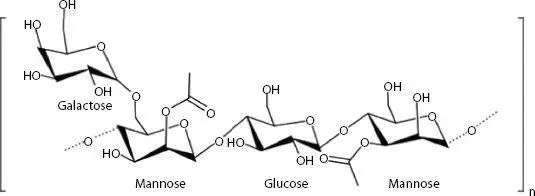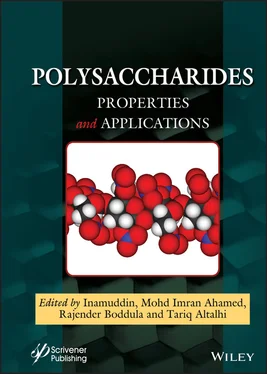1.1.1 Gel Composition from A. vera
Knowledge on the characteristics of A. vera allows a better understanding of the biochemical changes which take place during plant cultivation, processing and storage of its products. The gel consists predominantly of water (>98%) and polysaccharides, such as glucomannan, acemannan (acetylated glucomannan), mannose derivatives, pectins, cellulose, hemicellulose, of which acemannan is considered the main component [19]. Of the soluble sugars present in the gel, glucose accounts for over 95% [9].
According to Ni et al. [4], the sugar composition profile of the cell wall fibers, the micro-particles (degenerated organelles) and liquid gel was distinct. The mucilaginous gel, or simply gel, cannot be considered a homogenous entity, because it has three different structural components each with different chemical compositions. Galacturonic acid has been detected in the cell wall, suggesting the presence of high levels of pectin and pectic substances, the microparticles contained galactose-rich polysaccharide, and liquid gel containing mannose.
Two main types of polysaccharides present in A. vera gel are mannan-rich polysaccharides and pectic substances [33], where mannan polymer is the most studied polysaccharide from the pulp. And the liquid gel was considered the structural component owing to its viscosity and greater amount in terms of weight and volume, besides its contribution to the succulent nature of the plant. The mannan present in the gel is a soluble polysaccharide which confers the gel its viscoelastic characteristics [4].
The presence of mannose in the purified acemannan from fresh A. vera fillets ranged from 78.3 to 81.9% of the total monosaccharides, similar to data found by Chang et al. [34]. Glucose and galactose accounted for 10.1–11.7% and 4.8–6.8%, respectively (7).
However, Bozzi et al. [19] found that the fresh A. vera gel contained mainly fructose and glucose as free sugars (5.3 and 11.9 g/100 g of dry material, respectively) at a fructose:glucose ratio of 1:2. The gel also contained small amounts of free mannose, most likely from the degradation of the polysaccharide acemannan.
Chang et al. [34] conducted analyses of the amount of carbohydrate in the fractions of the skin, flowers and gel of A. vera , concluding that these fractions differ significantly, where gel contained 58.3% carbohydrate, the skin extract 37.3% and the extract from the flowers 23.4%. In 2013, Campestrini et al. [13] determined the composition of sugar in the crude extract of the pulp, where the glucose corresponded to 60.7% and mannose 28.7% as the main neutral monosaccharides, whereas for the polysaccharide fraction, glucose content was 3.9% and mannose 94.2%. The percentage of total uronic acid was 4.5 and 1.5% for the crude extract of pulp and polysaccharide fraction, respectively.
Chokboribal et al. [14] reported that the polysaccharide extracted was composed predominantly of mannose (57%), glucose (22%) and galactose (17%). Acemannan isolated from A. vera consists of a chain of tetrasaccharide of repeated units: O-(acetyl-D-mannose)O-(acetyl-D-mannose)-O-(D-glucose)-O-(acetyl-D-mannose) with a simple chain galactose at C6 of the second acetylated mannose residue [11].
Acemannan is a polysaccharide composed of β(1–4)-linked mannose residues, with acetylated C2, C3 and some galactose side-chains at C6, a feature leading to the acemannan denomination [9, 35]. On average, each mannose has one acetyl group in one of the three remaining ring positions (Figure 1.1) [10, 36].
Kiran & Rao in 2016 [37] found a higher amount of carbohydrates (72% wt/v) than polysaccharide (62% wt/v) in the fibrous fraction of mucilage, and confirmed that the major constituent in the composition of A. vera powders was polysaccharide. In their studies, Flores-López et al. [26] reported that the sum of carbohydrates and lignin found in the gel, liquid fraction and bagasse, corresponded to 57.45, 40.09 and 56.86% of the total of components present in A. vera . The authors also reported that, in all the fractions analyzed, glucose and mannose were found to be the major constituents at a ratio of 1:1. These sugars have been reported at various proportions as components of the polysaccharides of A. vera gel. They also reported the presence of a high amount of uronic acid and low amounts of galactose, confirming the occurrence of pectin polysaccharides in the gel and bagasse. Ray and collaborators [24, 25] reported that the concentration of polysaccharides varied with plant age and that plants cultivated for three years contained the highest concentration of polysaccharides, followed by the 4-year-old crop. Content also varied with time of harvest, with lower carbohydrate content during the rainy seasons.
According reported, the fluctuations in polysaccharide composition are most likely explained by seasonal influences on crop growth and by different levels of irrigation, given that the mannosyl residues are derived from the parenchyma store [9]. Thus, knowledge on how functional and bioactive properties vary with growth stage, including seasonal variation and age of plant, is of paramount importance [24, 25].

Figure 1.1Chemical structure of mucopolysaccharide acemannan.
1.2 Applications of A. vera Mucilaginous Gel or Fractions
A. vera mucilaginous gel is considered to be a potential source of natural polymers, having numerous applications in food, medicines and cosmetic products due to the presence of seventy-five potentially bioactive molecules, such as polysaccharides, proteins and glycoproteins [18, 29].
Acemannan alone was used in wound care pharmaceuticals and alveolar osteitis patients as Acemannan Hydrogel™ [4, 10] as well as Acemannan immunostimulant TM, used in fibrosarcoma treatment in cats and dogs [4, 21], and also in other products like Immuno-10 [38, 39], Alcortin ®[38], and Mole-Cure ®[40].
In this context, due the Aloe polysaccharides having the ability to swell, water retention capacity, or ability to adsorb organic molecules such as fatty acids [7, 20], represents a potential microencapsulation agent through spray drying process to produce functional food containing bioactive labile compounds, such as gallic acid and curcumin [41, 42].
The use of edible films in fruit has been applied to substitute fungicides, consisting of single biopolymers or combinations to other biopolymers, lipids, polysaccharides and proteins. These films can reduce the loss of water and respiration rate, besides showing antioxidant effects and potentially reducing the occurrence of damage and pathogens. There are several studies with A. vera mucilaginous gel as edible coating applied to fruit, such as bananas, apricots, strawberries, raspberries and papayas, maintaining quality and increasing their shelf life [43–45].
A. vera has also been extensively explored, along with other biomaterials, for application to tissue engineering. A. vera polymers have potential use as biomaterial due to advantages such as biodegradability, oxygen permeability, and antioxidant activity, as well as regeneration and cell proliferation stimulant properties. These extracts are also economical and show low toxicity [46].
Based on the previously mentioned properties, recent research on the use A. vera gel investigate its use conjugated to natural and synthetic polymers in order to produce 2D and 3D matrices, such as hydrogels, microspheres, sponges, nanofibers and functional films [47–50]. A large part of these biomaterials has been prepared by combining A. vera gel with cellulose, chitosan, alginates, gellan gum, tragacanth gum, poly(e-caprolactone), jelly, collagen and glucan [50–59].
Читать дальше

